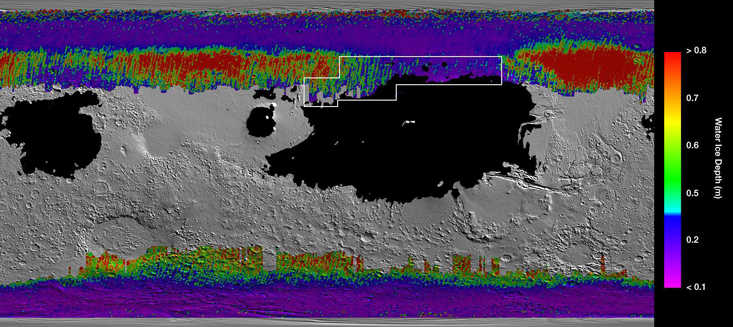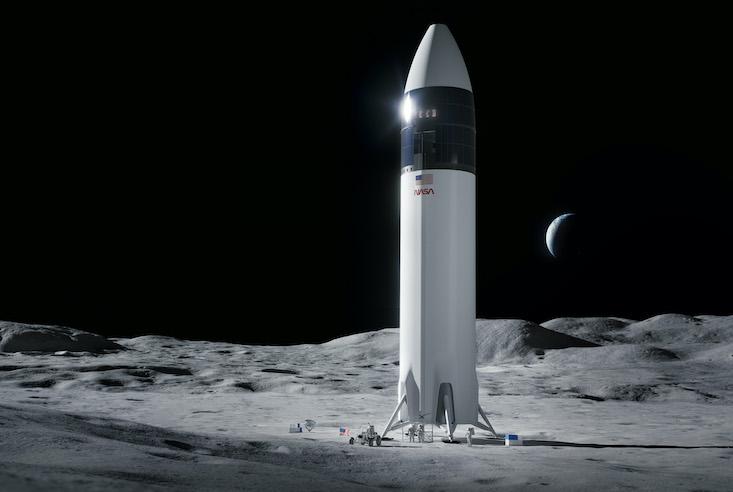Jennifer Heldmann laughed when I pointed out that she used the word “unprecedented” five times in a recent paper. “I should have checked that,” she said. But who could blame her? The NASA planetary scientist was describing a dream come true: The ability for humans to travel to the moon and Mars frequently—and not have to worry about packing lightly!
That’s because of a new vehicle the rocket company SpaceX is developing and testing, called Starship. It shatters the size and constraints with which scientists and engineers have had to content themselves. With space-bound instruments no longer needing to be painstakingly and expensively miniaturized, and with launch costs down and launch frequency up, NASA can think big—really big.

No one is more excited about this than Heldmann. She works at NASA’s Ames Research Center in the Space Science and Astrobiology Division and in the Planetary Systems Branch. She is an expert in the origin and evolution of water ice on the moon and Mars, and is intimately involved in planning, and campaigning for, human exploration missions on other worlds. Her paper, “Accelerating Martian and Lunar Science through SpaceX Starship Missions,” co-authored with two dozen other researchers, including employees at SpaceX, preceded some promising news. SpaceX is preparing the ground for Starship operations at Launch Complex 39A, part of NASA’s Kennedy Space Center near Cape Canaveral, the site that saw Apollo 11’s astronauts land on the moon. “39A is hallowed spaceflight ground,” Elon Musk, SpaceX’s CEO and chief designer, tweeted. “[N]o place more deserving of a Starship launch pad!”
Part of Heldmann’s mission is lighting a fire under the feet of her colleagues at NASA, to get them to start preparing missions aboard Starship as soon as possible, “potentially as soon as 2022, or failing that in the 2024 window,” she writes. In conversation, Heldmann spoke with the enthusiasm of someone psyched to see her life’s work reaching a pinnacle. “We’re doing something that’s never been done in human history before,” she told me. “It forces us to think about questions that haven’t been solved yet. That’s one of the most exciting things about working for NASA. Every day my job is different, because there is no answer in the back of the textbook.”
During our interview Heldmann explained, among other things, why water ice, the focus of her research, is the most valuable ingredient for expanding human civilization to the moon and Mars, and she outlined the unprecedented opportunities Starship offers for answering deep questions about life elsewhere in the solar system. Heldmann, who is no stranger to some of Earth’s most extreme environments, also didn’t rule out going to the Red Planet herself.
How are you laying the groundwork for human settlements on the moon and Mars?
I do terrestrial fieldwork and go to places on Earth similar to the moon and Mars to try and understand how the systems work, the underlying physics, so we can apply those lessons to the moon and Mars. As we go to the moon for longer periods of time and need to stay there and use in situ resources, water ice is on top of the list of things we’d like to investigate. And the same goes for Mars. If we want humans to live and thrive on the Red Planet, we’ll need to use in situ resources.
Where have you done terrestrial fieldwork?
I’ve been to the High Canadian Arctic—it’s very cool up there—looking for water and ice. I’ve been to the Dry Valleys of Antarctica, which is one of the best Mars analogues because it’s so cold and dry. There’s subsurface ice underneath a dry layer of regolith, just like we see on Mars. I’ve gone to the islands of Spitsbergen, which is north of Norway, where there’s very high latitude water springs coming through permafrost, which is very interesting—how you get liquid water at those cold temperatures. I’ve done work in the Atacama Desert looking at water flows under dry conditions. The Mojave Desert, Utah, Arizona—a whole bunch of places I never would have gotten to see if I weren’t a research scientist trying to go to extreme environments to see places that are most like off-world locations on the moon and Mars.
Water ice has the main constituents of rocket fuel.
What was your favorite trip?
Antarctica is amazing. It’s unlike anywhere else I’ve ever been. And when we go to the Dry Valleys, we fly into the U.S. base at McMurdo, gather up all our gear, do all our prep work, and then the helicopters fly us out to our field site. They drop us off for a month or two. You bring all your gear, your food, your fuel, everything you’re going to need, and then they come back and pick you up a couple months later. It’s spectacular.
What’s it like staying in Antarctica that long?
You realize that all these creature comforts that we have in our daily life really aren’t necessary for our survival. Even something as simple as taking a shower seems luxurious, because think about the resources—just taking a shower takes all this water. Having heat inside of buildings, having buildings at all—all these small things that we don’t think about in our daily life. But then when you become adjusted to living without them, you realize how well you can do and how much you can survive without having all these extra fancy things around you.
Tell us about Starship. What makes it special?
Starship is a large reusable vehicle that’s capable of taking about 100 metric tons of payload to the moon and Mars. It allows us to send more payload, send it more often, and most likely, at a lower cost. The way we do things now, we’re always conscious of mass. We spend a lot of money on miniaturizing components to make them fit within the small mass box. But if that goes away, then you can start flying more things. You can take things off the shelf more easily. You can also fly more of them and lower your risk. If a couple of instruments don’t work, then that’s fine, you still have data from all the rest. It’s really thinking in a different way. We can start asking, “What science could I do if I could have all of these flight opportunities, if I could fly this much mass?”
What can mission planners do to help prepare the way for humans to explore and live on Mars?
There’s a laundry list of other activities you can do: What’s your power infrastructure going to look like? What testing can you do for power systems, characterizing the local environment of where the humans will be? What are the variations in surface temperatures? Are there dust storms, atmospheric pressure changes? Humans will need long-term radiation shielding. You can test the effectiveness of different techniques. You can look at how you’re going to grow food when you have a lot of humans there. You can start with some simple plant-growth experiments that have been designed already. You can preposition supplies. You can start bringing some of the hardware that you’re going to need when the humans come and get it in place before they get there. You can start preparing landing pads. As you have multiple Starships coming and landing, instead of landing on native Martian terrain, you can do some experiments early with different landing components and techniques for creating landing pads, to see which ones work best.

Is there a sweet spot for where to land on Mars?
We’ve been doing some of this work, looking at optimal landing sites, because you want to find the sweet spot where you want to be close to the equator, because the temperatures are warmer, the thermal environment is more benign. We have a very nice day-night cycle. However, you want to be at a far-enough, sort of northern latitude, so that you have near-surface ice. We’ve seen impact craters that have excavated ice. We have multiple different datasets suggestive of ice. But we really need to get on the ground in those locations where we consider sending the humans and do the finer-scale, human-scale mapping to see what the distribution of that ice is, how pure it is, how deep it is.
Why is it crucial to be close to easily accessible water ice?
Water ice is important because that’s going to be a fuel source. Water is made of hydrogen and oxygen, H20. Those are the main constituents of rocket fuel. So, in one of the leading contenders for the mission architecture, you’re going to make your return-to-Earth Starship fuel from in situ resources on Mars from the water. You can also use some of that fuel in the base, to support the humans while they’re there too, to brush your teeth and take a shower and grow your plants and all those things, too.
Do you know how much water ice Mars has? Is there a worry of running out?
There’s a lot of ice sequestered, especially on Mars. We have all sorts of data. We have gamma-ray data and radar data and geomorphic data, modeling results that are consistent with this. If you want to go far north, there’s polar caps that have water ice in them. There’s small amounts of water in the atmosphere. So, there’s a vast amount of water. It’s an interesting science story, too, because billions of years ago, Mars had large volumes of flowing liquid water. We see giant canals and riverbeds that tell us that there was a lot of liquid water on Mars. That liquid water escaped and/or froze, and now Mars is a very dry place on the surface. It’s just a matter of picking the optimal location for the human base.
How versatile is Starship as a human base—what can you do with it once it lands?
There’s a lot of architectural versatility that’s provided just with the structure itself. A lot of interior volume, for example, and you can repurpose that volume depending on your mission needs. You can have crew compartments. You can have large bulk spaces for sending large spacecraft. There are pods on the bottom, so you can have easy access to the surface. There can be an elevator, so you can lower payloads down to the ground, if you need to. On early flights, you can even use some of that material for building up your base.
Starship can return more samples than we have ever dreamed that we could have.
Do you think you’ll find fossils of past life, if life did evolve, on Mars?
I don’t know. That’s why it’s so interesting to explore Mars, because we don’t know. We don’t know if there was life there. We don’t know if there’s still life there. Maybe there was never life there. That is the $1 billion question, right? But all the conditions seem to have been on Mars, especially around the time that we believe life started to evolve on Earth—warmer weather conditions, energy sources, and the organic elements. And if there was, is it similar to life on Earth? Is it different? Or did life evolve independently on both planets? The answer either way would be profound because that would help tell us about our own place in the universe. How common is it for life to emerge? Looking at our solar system, and then extrapolating that to other solar systems. That’s one of the reasons why Mars is so interesting, because we can start to address some of these big-picture questions by going to the next planet over.
A single Starship heading to the moon, you write, could bring back more lunar samples than we have now.
Correct. I’m glad you pointed that out because that’s the other end of the story. Because Starship’s reusable, and because it has such a high-payload capacity, you can return more samples than we have ever dreamed that we could have. And samples are incredibly valuable for science, because we can get the samples in the labs on the Earth, where we have the state-of-the-art, the most highly capable instrumentation, to do that sample analysis. That’s a game-changing proposition to be able to bring back so many samples. The diversity of samples will be higher because you can pick and choose what you leave.

It can also help us bring back unique samples. For example, the south pole of the moon is interesting because there are these permanently shadowed craters. And we’ve had multiple missions now telling us there’s probably water ice and other frozen volatiles in these dark craters and around them. We’d really like samples of that very cold material. But to bring back samples of that cold material is hard, you have to keep them cold as they get back to Earth. You need refrigerators at very low temperatures. And that means mass. So, it’s hard for us to fit a decent size refrigerator on a current vehicle. If you have something like Starship, you can fit some big freezers in there to keep your samples cold. You can get those ices back to the Earth for analysis.
Tell us about the epiphany you had while trying to understand how water flows on Mars.
There are features on Mars that look just like terrestrial gullies on Earth. There’s V-shaped channels, they are meandering, they have debris when you hit the bottom, they have eroded alcoves up at the top—exactly the morphologies you would expect when you’re looking at water flows on Earth. And they’re usually on crater walls or the side of slopes. They’re geologically young, probably the past few million years. That’s interesting because how can you have recent water flows on Mars? We always thought Mars is too cold and too dry and the atmosphere is too thin to have liquid water.
It turns out that, when you look at most of the gullies on Mars, they don’t reach the bottom of the slope, which is interesting, because that means you’re losing water along the way. Why does water behave this way on Mars? We know the atmosphere is so thin. We know that the temperatures are so cold. So when liquid water is exposed to the Martian surface, it boils and evaporates at the same time. You can model the rates of that. To match the length and the shapes of the channels, you had to be losing large volumes of water as it was flowing down the surface. We also know there were vast quantities of water early in Mars’ history because we see these large valley networks and these large channels and riverbeds and shorelines and all this evidence telling us that there was a lot of liquid water in the past.
You’ve said that you used to want to go to Mars yourself but changed your mind. You’ll let others have the fame and glory. But you don’t have to be the first, you can visit the red planet when SpaceX’s habitat is more established. So, might you reconsider going?
I guess we’ll have to see how it plays out. I think one of the things I learned through working at NASA is just how much work is required on the ground to enable even just a few astronauts to fly into space. And it’s all incredibly important work. And it’s all leading toward the same goal. So, I found that I’m very happy doing that hard work on the ground to enable others to go.
One of the fathers of rocketry, Konstantin Tsiolkovsky, said, “Earth is the cradle of humanity, but one cannot remain in the cradle forever.” Do you see Earth as a place we must outgrow to mature as a species?
I love that quote. Studying planetary science, I realized that there are other worlds out there. I mean, our planet Earth is amazing. I have been very fortunate to have been able to go to places that most people don’t get to go to just through the course of my research in my work, going to extreme environments, and places that are not tourist destinations and don’t have hotels and whatnot. The more we can understand and appreciate our natural world, and how fortunate we are to have this planet, all the better.
In learning about our Earth, I can also appreciate that there are also other worlds out there that are also fascinating, from the spacecraft that we’ve sent and the data we’ve gotten back, we are always surprised. We think we know. We develop theories, and we think about what we think we’re going to see. And then nature always surprises us. I expect it will be no different when we’re exploring the moon even more, when we send humans to Mars and beyond. We will continue to learn, and I think that’s our human nature—to explore. That’s what we do.
Brian Gallagher is an associate editor at Nautilus. Follow him on Twitter @bsgallagher.
Lead image: Paopano / Shutterstock
















